|
"I have no hostility to nature, but a child's love to it. I expand and live in the warm day like corn and melons." -Ralph Waldo Emerson The fall rains are here bringing back ditches that went dry in July. This is only the second time in 16 years I have seen this happen in Crestone. A foretelling of more to come? Or just the punctuated equilibrium that nature loves? Here's the box: Cantaloupe, COG, Hirakata Farms, Rocky Ford 1 melon Purple Beans, COG, White Mountain Farm 1 pound Living Spring Mix Lettuce Heads, Brightwater Farms, Monte Vista 1 clamshell Portabella Mushrooms, Colorado Mushroom Farm 2 caps Grilling Onions, COG, White Mountain Farm 1 bunch Hopi Corn, COG, Archaic Orchards, San Isabel Creek 2 ears Cornmeal, non-GMO, Bow & Arrow Brand, Towaoc, CO 24 oz Due to super rainy conditions this August which led to muddy field conditions and slow growth of the plants, our Organic baby greens from Ring a Ding were unavailable. So we went with the Spring Mix from Brightwater Farms in Monte Vista. We have had a lot of discussion about the hydroponic method of growing plants and it seemed a lot of people were not sure exactly what it meant. Here's a brief synopsis. Hydoponics 101: Hydroponics is the growing of plants without soil where the plants' roots are directly immersed in an aqueous nutrient solution, or they are in an inorganic substrate that the nutrient water can flow through, such as perilite or clay pebbles. The inorganic or organic nutrients are more or less the same principle nutrients that are derived from the microbiology of the soil, but instead of being produced in the soil, or added to the soil via green manure or compost, they are usually produced somewhere else and imported in to the hydroponic facility where they are then mixed with water and fed into the system. In general, there is a whole lot more going on in the soil than in a hydroponic nutrient solution, but plant chemistry has allowed us to isolate the proper nutrients and proportions to what is needed to grow healthy plants. Due to the presence of more oxygen in the roots systems of hydroponic plants (due to forced aeration, drain and fill systems, or aeroponics), they are able to take up more nutrients. The benefits of hydroponics are that plant growth is 30-50% faster and the plants can be bigger than in the soil as the plants do not have to work as hard to access their nutrition. Due to hydroponics usually being found in controlled, year-round indoor environments with automated heating, cooling and watering, there is also no expense in weeding, no fossil tractor expenses or inputs, less disease, and less water consumption as the water is continually recirculating. Per square foot of land and per gallon of water, hydroponics can produce far more food than their soil counterparts. By no means is this to say we should abandon soil agriculture, but it is to say there is a place for hydroponics, and especially aquaponics where the nutrient source comes from co-located fish aquaculture. And fresh, lettuce, kale, and basil year round at 7200 feet in high alpine Colorado is something special. We're talking about feeding 7-8 billion people in the very near future and we're going to need all the techniques available to produce healthy food. Brightwater Farms is a progressive family business that is USDA GAP Certified (Good Agricultural Practices) and has a high degree of product quality and food safety standards. All their inputs that they might use are OMRI certified (Organic Materials Review Institute), meaning these same inputs can be used in Organic agriculture. Below is brothers Andrew and Robert Toews of Brightwater Farms in Monte Vista. Sweet Hopi Blue Corn from Tom McCracken, formerly of Green Earth Farm and now from Archaic Orchards on San Isabel Creek near Crestone. This is a special offering from veteran farmer Tom McCracken who just can't keep out of growing food. He seems to be keeping busy over on San Isabel growing an orchard, a raspberry crop, and this Hopi Sweet Blue corn that he has been saving the seed for many years. Non-GMO Cornmeal from Bow & Arrow This is also a special offering grown by on the Ute Indian Reservation near the Four Corners in Colorado. Certified non-GMO, ancestral corn grown in ancestral lands. http://www.bowandarrowfoods.com/ From Megumi's Kitchen "Remember "the three little pigs and the big bad wolf”? "Who’s afraid of the big bad wolf, big bad wolf, big bad wolf?”. When you see an unfamiliar veggie in a CSA box or too much of one thing in your kitchen, replace “big bad wolf” with the name of the veggie. Tadah… an idea for a yummy dish appear magically! --- Portobello mushroom BBQ --- When I first saw a portabello mushroom, I was intimidated by the size. When I had one at a restaurant, I did not like it because the mushroom was grilled whole and had unappealing look. Plus the seasoning was quite plain. In our kitchen, I slice it in about 1/2 inch thick, marinade it in advance, and pan fry them. It’s great as is or for a sandwich. I bet you can BBQ then on the grill too. - scrape off the brown part of the mushroom in the back with a spoon - dust off the mushroom (if you prefer, wash and dry it). - slice it in about 1/2 inch thick - in a casserole dish (or any other dish with some depth) mix catsup, soy sauce, and sake (or white wine). sprinkle some chili pepper if you’d like some heat. season with salt and pepper to your liking. - marinade the mushroom slices for about 10 minutes or longer - in a pan heat enough oil to cover the bottom - sear the mushroom slices on both sides. - when the mushrooms are done, pure in the sauce and cook till the sauce is caramelized. — Green Beans Japanese Home Cooking Style -- When I say “Japanese cooking is boring,” people in US look at me in disbelief. But for me who grew up in a Japanese household, a Japanese meal means rice, miso soup, grilled fish, and some veggies cooked with sugar and soy sauce. How boring! :) Here is the “sugar and soy sauce” seasoned beans that was typical on our dinner table back in Tokyo. - clean and prep the beans - in a sauce pan, heat cooking oil and sauté the beans - sprinkle about 1 teaspoon full of sugar and 2 teaspoon of soy sauce - add water to cover the beans - put the lid on and simmer till the beans are soft - if the beans do not get soft before the liquid evaporates out, add some more water. if the beans get soft enough while liquid is till in the pan, take the lid off and cook it down until the sauce starts to caramelize. p.s. today I am using the purple beans that came in the CSA box. I love the color and wish the color stays after cooking! — Tamale Pie ‘wannabe' --
I am always a bit nervous when I borrow names of dishes from culinary cultures not of my own. This “tamale pie” is one of them. Being not from SLV originally, I did not know what to do with Calbacitas until a few years ago. When I was singing “who’s afraid of calbacitas, calbacitas…” someone local taught me to cook it with onion, garlic, and corn. That dish reminded my culinary partner of his mother’s “tamale pie.” This is my interpretation of wannabe a tamale pie. ingredients: - 2 cups cornmeal - 1/2 to 1 stick of butter (or shortening, or lard) - 1 & 1/2 cups of broth - 1 teaspoon salt - 1 calabacita (or zucchini, or any other squash) - 1 onion - 1 ear of corn (or frozen/canned kernels of corn) - 1 tomato (green tomato is fine too) - 2-3 clove of garlic - salt and pepper - 8-10 black olives, chopped - feta cheese, crumbled - Colby or some other melting type of cheese for garnish, shredded 1) chop calabacita, onion, and tomato. take corn kernels off the ear. mince the garlic 2) in a sauce pan, heat oil and sauté onion till transparent, season with garlic, salt, and pepper. 3) add tomatoes, calabacitas, and corn and sauté till all are cooked. season more. set aside. 4) in a bowl, soften the butter and whisk till creamy 5) add the cornmeal 6) add the broth, adjusting the thickness so that the batter is wet but not running 7) grease the baking dish, take about a half of the corn batter and make the bottom layer 8) mix in the feta cheese and olives in the veggie mix, pour over the bottom layer to make the middle layer 9) place the rest of the corn batter evenly on top to cover the veggie mix 10) bake it at 375 for 30 minutes, sprinkle shredded Colby cheese, and bake for another 15 minutes or until nicely brown
0 Comments
Leave a Reply. |
Archives
June 2024
Categories |

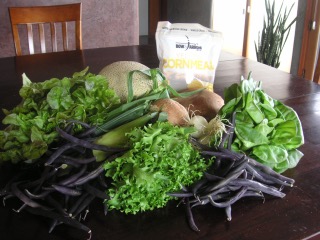
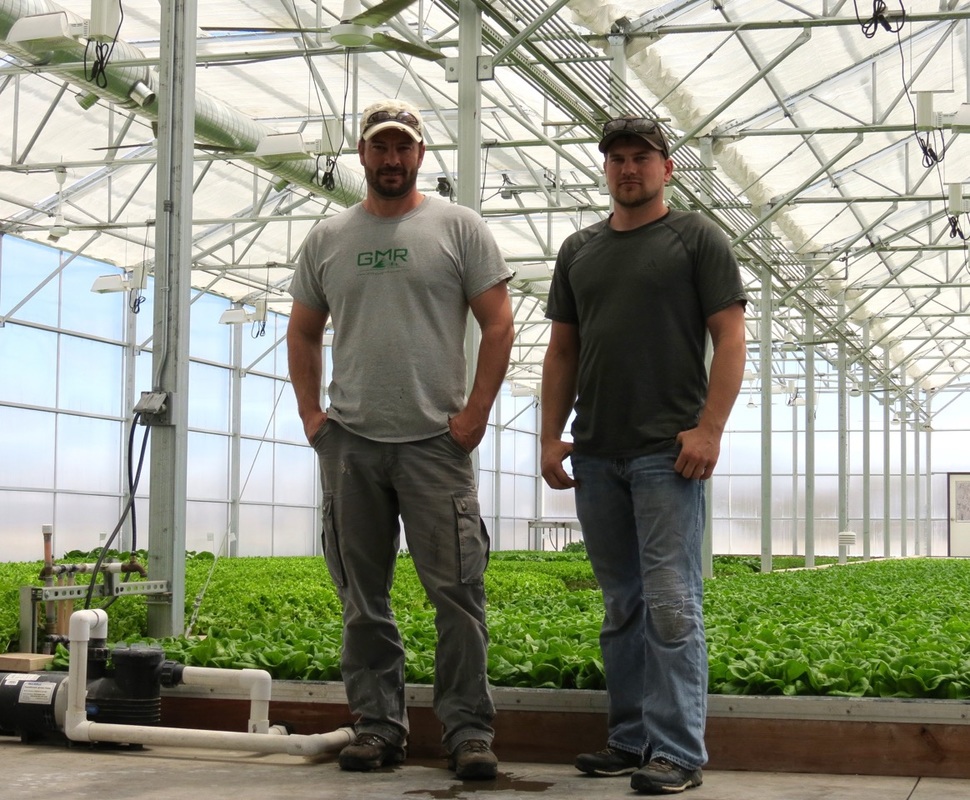

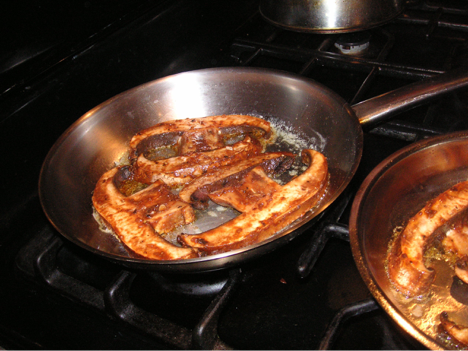
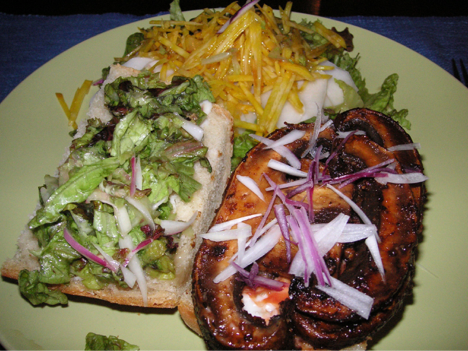

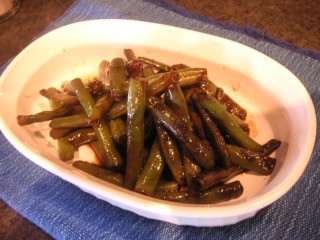
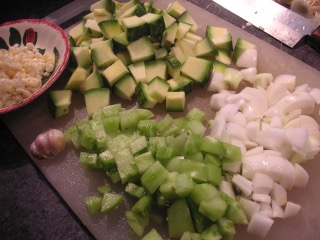
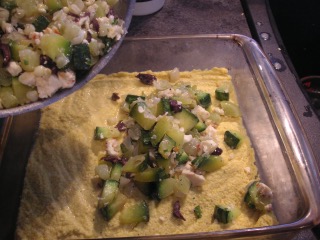
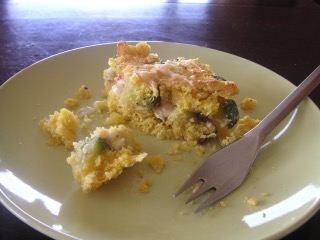
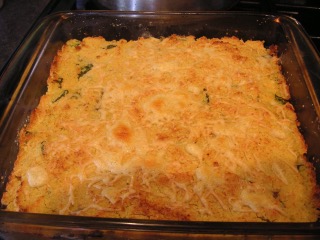
 RSS Feed
RSS Feed

